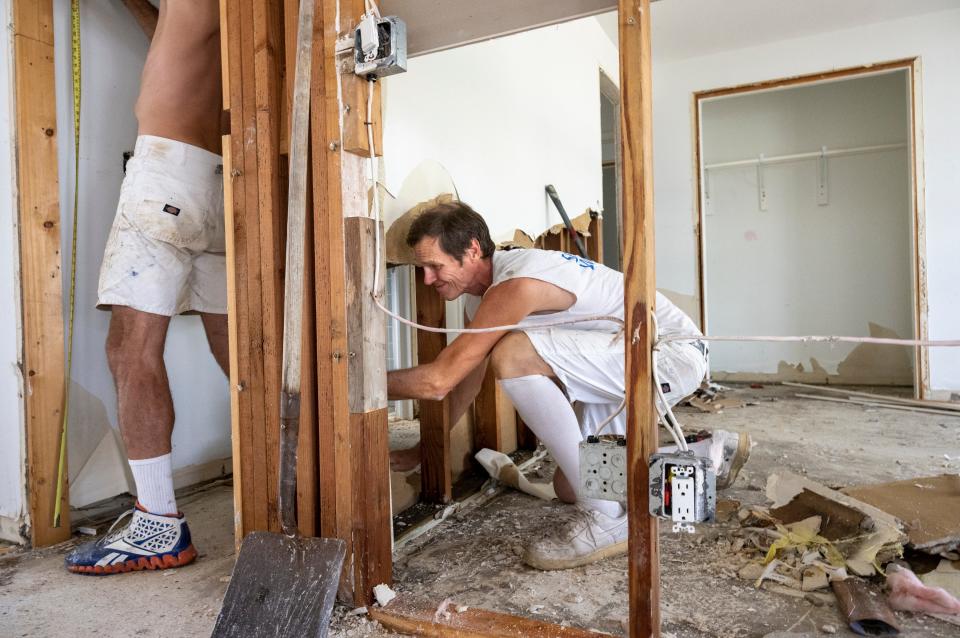With FEMA housing slow to arrive, most pass on the option in Collier County
Nearly 1,000 households in Collier County have qualified for direct housing from the Federal Emergency Management Agency in the aftermath of Hurricane Ian.
As of Friday, the count stood at 917, but nearly 80% of the eligible households have found other alternatives and passed on the option of FEMA-provided housing, said Cecily Fong, a media relations specialist for the agency, in an email.
Direct housing is often in the form of travel trailers or mobile homes placed on private property, such as in a driveway, or yard.
The assistance program also offers readily-available housing leased by FEMA, as well as multi-family housing that FEMA will repair and lease out.
Direct housing may be provided for up to 18 months after the date of a disaster, which would sunset the program in Southwest Florida by March 2024.
The program is designed for residents whose homes became uninhabitable because of the hurricane – and whose housing needs are not covered by insurance.
Earlier:Collier commissioners frustrated over lack of temporary housing for Ian victims
More:FEMA to provide trailers, manufactured homes for displaced Hurricane Ian survivors
Of all the households that have sought FEMA disaster assistance and qualified for its housing in Collier, 174 of them "have expressed a continued need for temporary housing," Fong said.
"Households that are eligible for direct housing are automatically identified through the regular FEMA application process based on real property damages/losses documented by a FEMA inspector. There is no separate application," she said.
She shared that FEMA and its contractor have made site visits in Collier County to determine if FEMA trailers or mobile homes can be placed on specific properties.
"There are currently seven haul and install work orders in progress for Collier County," Fong said, with all of them in the installation stage.
FEMA considers many factors in deciding where it can put its temporary housing.
"Factors that can affect whether a unit can be placed on a specific site include being in a flood zone, small lot size that is unable to accommodate the specific type of FEMA unit, utility connection issues, the need for major debris removal, and sewer connection issues," Fong said.
FEMA can't put trailers or mobile homes in "V" zones or other coastal high-hazard areas, or floodways. A "V" zone usually includes the first row of properties on the beachfront.
"Many private sites along the coast are excluded because of this. However, even though we cannot place a unit on that specific private site, the household remains eligible for FEMA direct housing," Fong said.
Even if the environmental and mitigation reviews come back viable, the private lot’s size or local codes may restrict FEMA’s ability to place its housing on that site, she said.
"We must ensure that the FEMA units are placed in accordance with all applicable local codes and ordinances, state law and regulations, and federal regulations and statutes," Fong said.
Qualifying residents can be placed at trailer parks, or other group sites, if they don't have a suitable location of their own.

Seven counties have been approved for direct housing assistance as a result of Ian, due to a shortage of hotel rooms and other alternatives in those areas. The other counties are: Charlotte, DeSoto, Hardee, Lee, Sarasota and Volusia.
While Southwest Florida already had a housing crunch resulting in sky-high rental prices, Ian has wiped out enormous swaths of housing, making it that much harder for year-round residents to find a place to live.
FEMA and the state of Florida first activated the Transitional Sheltering Assistance program, which allows FEMA to directly pay participating hotels and motels in Alabama, Florida and Georgia an agreed-upon rate to provide emergency shelter to survivors.
While FEMA will pay hotel and motel costs for displaced residents, the program has not been heavily used in Southwest Florida, with a limited number of participating hotels in Lee or Collier.
Statewide that program is providing housing for more than 1,630 households, with nearly 4,000 individuals.
More than 3,600 FEMA registrants have qualified for some type of housing assistance in Collier, including rent relief, Fong said.
FEMA's direct housing program criticized for its red tape
Direct housing is a slower process that's often drawn criticism for its bureaucratic red tape.
Asked if he's heard any updates on how the program is going in Collier, County Commission Chairman Bill McDaniel said: "The short answer is I've heard they are moving forward, but they are moving at tortoise pace, at snail's pace."
At the last county commission meeting, the board heard from county staff that FEMA had placed a little over a dozen trailers in Southwest Florida.
Permitting for the temporary housing is handled locally.
"There is no fee or anything for these things," McDaniel said. "It just takes an enormous amount of time."
Frustrated by how long it's taking for the FEMA housing to arrive, county commissioners have asked staff to look into the pros and cons of allowing Collier's displaced residents to live in privately-owned campers or trailers on lots in what's described as "urban Golden Gate Estates," essentially the more developed area of the estates, west of Collier Boulevard.

County staff is expected to report their findings and make recommendations at the next commission meeting, scheduled for Jan. 10.
If allowed, the temporary housing would likely be restricted to six months, at least initially, with a required status update by then, to ensure owners are moving forward with construction or reconstruction to replace or fix up their damaged homes, McDaniel said.
"That doesn't stop the effort of FEMA," he said, or the ability for anyone who qualifies to seek government help later on, once the federal housing starts to arrive in force.
"At my last count, there were 100 properties rendered uninhabitable. And those folks need some help," McDaniel said.
He described FEMA's direct housing program as counterintuitive, as it won't provide housing to many of the residents hit hardest by Ian, living near the water in flood-prone areas.
"The whole rational behind campers is they are mobile," McDaniel said. "And, so, if another storm comes before you're ready, you can quickly unhook and run for high ground with your camper."
In harder hit Lee, County Manager Roger Desjarlais recently tore into the federal government's go-slow approach in providing housing relief.
In case you missed it:Desjarlais: Feds' post-Ian housing planning is 'bureaucratic nonsense'
Earlier this month, FEMA shared that more than 12,000 people had qualified for direct housing in Lee, but there were only a handful of trailers on the way.
"I've never heard so much baloney in my life," Desjarlais said at the time. "The bureaucratic nonsense is about to make my head explode."
FEMA representatives have blamed local zoning as one of the culprits.
County officials, however, are not convinced that local rules have prevented the installation of trailers in flood-prone areas.
"We continue to work with FEMA officials here, on the ground. Nothing has surfaced so far to mean we can change ordinances or regulations that would permit those trailers in those areas," said Assistant County Manager Mark Mora a few weeks ago. "There is nothing that we are aware of that we could change that would expedite or allow them to put them there."
In Lee, 48 work orders have been issued for FEMA-provided housing, so far, Fong said.
While more than 12,700 people have qualified for the government housing in the county, she said "only 2,212 have expressed the need" for it.
FEMA has provided rental assistance to 19,177 households in Lee, valued at $50.7 million, to jumpstart their recovery.
In Collier, 3,291 households have received the same kind of financial help, totaling $11 million.
Meanwhile, 40 households in Collier and 1,622 in Lee are staying in hotels through FEMA's transitional sheltering program across Florida, Georgia and Alabama.
News-Press government and politics reporter Bill Smith contributed to this story.
This article originally appeared on Naples Daily News: FEMA trailers slow to arrive in Collier County post-Ian

